May 2019 Horticulture News
go.ncsu.edu/readext?602838
en Español / em Português
El inglés es el idioma de control de esta página. En la medida en que haya algún conflicto entre la traducción al inglés y la traducción, el inglés prevalece.
Al hacer clic en el enlace de traducción se activa un servicio de traducción gratuito para convertir la página al español. Al igual que con cualquier traducción por Internet, la conversión no es sensible al contexto y puede que no traduzca el texto en su significado original. NC State Extension no garantiza la exactitud del texto traducido. Por favor, tenga en cuenta que algunas aplicaciones y/o servicios pueden no funcionar como se espera cuando se traducen.
Português
Inglês é o idioma de controle desta página. Na medida que haja algum conflito entre o texto original em Inglês e a tradução, o Inglês prevalece.
Ao clicar no link de tradução, um serviço gratuito de tradução será ativado para converter a página para o Português. Como em qualquer tradução pela internet, a conversão não é sensivel ao contexto e pode não ocorrer a tradução para o significado orginal. O serviço de Extensão da Carolina do Norte (NC State Extension) não garante a exatidão do texto traduzido. Por favor, observe que algumas funções ou serviços podem não funcionar como esperado após a tradução.
English
English is the controlling language of this page. To the extent there is any conflict between the English text and the translation, English controls.
Clicking on the translation link activates a free translation service to convert the page to Spanish. As with any Internet translation, the conversion is not context-sensitive and may not translate the text to its original meaning. NC State Extension does not guarantee the accuracy of the translated text. Please note that some applications and/or services may not function as expected when translated.
Collapse ▲Fire Blight
Fire blight can be a devastating disease on trees and shrubs within the Roseaceae (Rose) family. This includes plants such as quince, cherry, pear, apple, and roses. All of these are susceptible to the bacterium Erwinia amylovora or fire blight. Fire blight attacks the blossoms, leaves, shoots, branches, fruits, and roots of plants. One of the first noticeable symptoms is during spring when blossoms become wilted and turn black. During the growing season, you will see the growing tips of shoots and twigs begin to wilt and form what looks like a shepherd’s crook. Eventually, an entire limb will give the appearance that it’s been burned with a blow torch; hence the name given to this disease. The bark at the base of infected branches become water-soaked, sunken, and eventually dry out. Cracks will also develop along the edges of the canker. Fruit remaining on infected branches will ooze a milky substance and eventually shrivel and mummify and remain attached to the branch. During hot & humid conditions branches will begin to ooze this substance as well. This ooze contains the bacteria of the disease. The bacteria overwinter in cankers on infected trees. The bacteria are then transported by rain, wind, and insects to other parts of the plant. The disease enters the tree through natural openings, wounds, and flowers. The bacteria can survive through the winter in sunken cankers on infected branches. It is recommended to prune out diseased limbs at least 6-8 inches below the site of infection. Also, make sure to sterilize your pruners after each cut with a 1:10 Clorox solution. If you know fire blight is present, limit application of nitrogen fertilizer as this encourages succulent growth which is most susceptible to infection. There are also chemical copper and bactericides available for use as well.
Colby Griffin is the horticulture agent for the Franklin County Center of N.C. Cooperative Extension. If you have any questions about this article or other gardening issues, he can be reached at colby_griffin@ncsu.edu or 919-496-3344.
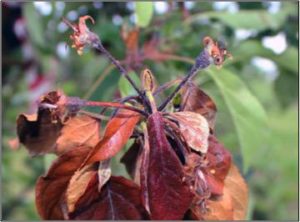 Blossom Blight on ‘Gala’ by Kerik Cox, Cornell University. |
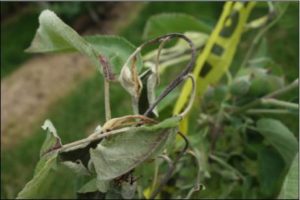 Shepherd’s crook and mid-vein blackening on ‘Gala’ shoot infected by E. amylovora Kerik Cox, Cornell University. |
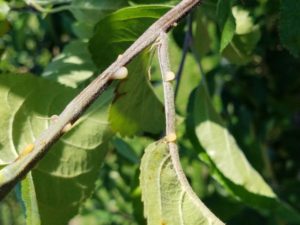 Bacterial ooze resulting from a blossom blight infection on ‘Rome Beauty,’ by Sara Villani, NC State University |
 Ooze on a rootstock infected by E. amylovora. Deborah Breth, Cornell Cooperative Extension |
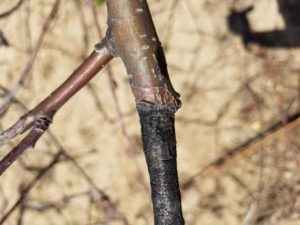 Fire blight canker on ‘Rome Beauty.’. Sara Villani, NC State University |
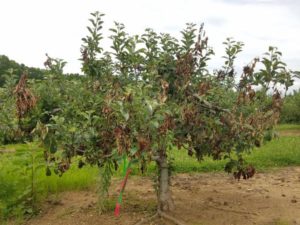 Rome Beauty’ with several fire blight strikes. Sara Villani, NC State University |
Watch for Predators That Look Like Pests
Yesterday on campus willow oak trees I found lots of insects that looked like mealybugs. But they were faster than mealybugs and constantly moving around the tree bark. Mealybugs don’t move much. It turns out these are the larvae of lady beetles that specialize on scale insects. Oak lecanium scales are primary pests of willow oaks and these special lady beetles are primary predators of lecanium scales and other scales like tulip tree scales. These are larvae of specialist lady beetles that eat scale insects. As all the lecanium crawlers hatch out these lady beetle larvae are hatching too. These lady beetles are in a couple related genera probably including Hyperaspis spp. You can read more about them in a previous post with great drawings. The important thing is to recognize they are not pests, they are predators so you can calm people (yourself) down who fear for their trees and may what to spray them.
Read more: Predators that look like Pests
Southern Red Mites Active on Ornamentals
In North Carolina, the most important cool season mites are the spruce spider mite (Oligonychus ununguis) and southern red mite (Oligonychus ilicis). These are among the earliest and most damaging pests in nurseries and landscapes. As their name implies, cool season mites are active in spring and fall when they suck fluid from cells on plant leaves and needles. In hot summer months, these mites are dormant. Today I found severe infestations of southern red mites on cherry laurels around campus. Southern red mite feeds on broadleaf evergreens such as azalea, camellia, holly, and rhododendron. Cherry laurel is a reliable and favored host. Spruce spider mite feeds on coniferous evergreens such as spruce, juniper, hemlock, and arborvitae.
Read more: Southern Red Mites
Register Now: Sandhills Turfgrass Regional Conference and Field Day June 12
4.5 (L N D X) N.C. Department of Agriculture & Consumer Services pesticide credits approved: join us for the Sandhills Research Station (SRS) Turfgrass Regional Conference and Field Day Wednesday, June 12 from 7:30 a.m.–12:45 p.m.
- Advance registration is $20 and includes lunch.
- Special discounted fee for TCNC members is $5.
- On-site registration is $25, but space is limited.
- Pre-registration is strongly recommended to guarantee a spot. No refunds for this event.
Chinch Bug Activity in Turf
There are more than 20 Blissus species native to North America but only four are reported pests of turfgrass: the common chinch bug (Blissus leucopterus leucopterus Say), the hairy chinch bug (Blissus leucopterus hirtus Montandon), the southern chinch bug (Blissus insularis Barber) and the western chinch bug (Blissus occiduus Barber). Of those four species, only the southern chinch bug is a common turfgrass pest in the Southeast.
Description – Southern chinch bug adults are oblong, oval, and black with shiny white wings; each wing bears a distinctive, triangular black mark. They are approximately 0.1-0.2 inch long
Read more: Chinch Bug
Tomato Spotted Wilt Virus
Do Your Tomatoes Have Spotted Wilt Virus? Find Out Here!
Lately, we have seen a lot of tomato samples with tomato spotted wilt.
Read more: Spotted wilt virus
Cottony Maple Leaf Scale
Cottony Maple Leaf Scale is one of several cottony scales in the genus Pulvinaria. Cottony camellia scale and cottony maple scale are the other common species. You can find these now on their most common hosts: maple and dogwood. Stand under a tree and look up and you will see cottony masses about the size of a cotton swap stuck to the bottom of leaves. These are the egg masses. These are the egg masses. They each contain many hundred eggs that will hatch soon. The crawlers will settle and feed on the leaves all summer then migrate back to branches in fall before leaf-drop.
Read more: Cottony Maple Leaf Scale
Update on H-2B Visas
The Departments of Homeland Security and Labor plan to officially release a rule tomorrow that kicks off an application process for an additional 30,000 H-2B visas for fiscal 2019. These visas will be limited to returning workers who received H-2B visas in one or more of the previous three fiscal years (2016, 2017 or 2018).
Beginning tomorrow, May 8, employers with a valid Department of Labor temporary labor certification for a start date of April 1 can apply directly to the Department of Homeland Security – US Citizenship and Immigration Services (USCIS) without re-advertising or going back through the DOL process, provided that their visa petitions are submitted to USCIS before the expiration of their labor certification, which should run through May 14.
Employers will also need to submit an attestation form that without H-2B workers, the employer will suffer “irreparable harm” or permanent and severe financial loss. The attestation form will be available tomorrow from the Department of Labor. It should be posted at this page: Forms. After May 14, employers will need to re-advertise jobs and file a new application for labor certification with DOL.
View a pre-publication copy of the rule: H2B Visas update




